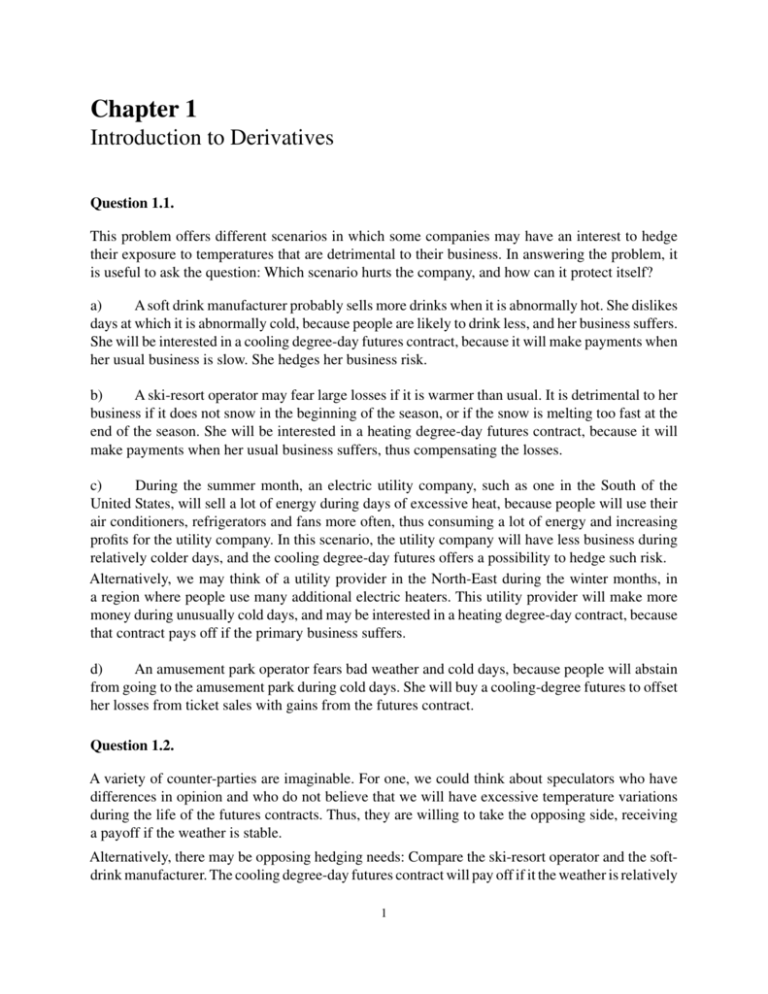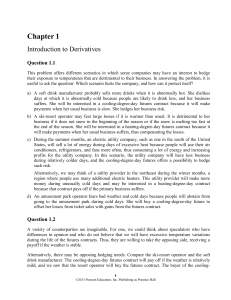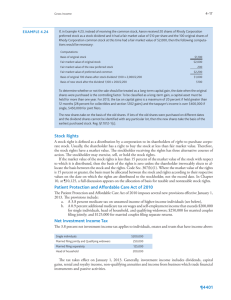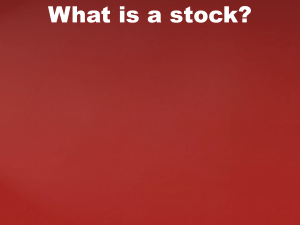Chapter 1
advertisement

Chapter 1 Introduction to Derivatives Question 1.1. This problem offers different scenarios in which some companies may have an interest to hedge their exposure to temperatures that are detrimental to their business. In answering the problem, it is useful to ask the question: Which scenario hurts the company, and how can it protect itself? a) A soft drink manufacturer probably sells more drinks when it is abnormally hot. She dislikes days at which it is abnormally cold, because people are likely to drink less, and her business suffers. She will be interested in a cooling degree-day futures contract, because it will make payments when her usual business is slow. She hedges her business risk. b) A ski-resort operator may fear large losses if it is warmer than usual. It is detrimental to her business if it does not snow in the beginning of the season, or if the snow is melting too fast at the end of the season. She will be interested in a heating degree-day futures contract, because it will make payments when her usual business suffers, thus compensating the losses. c) During the summer month, an electric utility company, such as one in the South of the United States, will sell a lot of energy during days of excessive heat, because people will use their air conditioners, refrigerators and fans more often, thus consuming a lot of energy and increasing profits for the utility company. In this scenario, the utility company will have less business during relatively colder days, and the cooling degree-day futures offers a possibility to hedge such risk. Alternatively, we may think of a utility provider in the North-East during the winter months, in a region where people use many additional electric heaters. This utility provider will make more money during unusually cold days, and may be interested in a heating degree-day contract, because that contract pays off if the primary business suffers. d) An amusement park operator fears bad weather and cold days, because people will abstain from going to the amusement park during cold days. She will buy a cooling-degree futures to offset her losses from ticket sales with gains from the futures contract. Question 1.2. A variety of counter-parties are imaginable. For one, we could think about speculators who have differences in opinion and who do not believe that we will have excessive temperature variations during the life of the futures contracts. Thus, they are willing to take the opposing side, receiving a payoff if the weather is stable. Alternatively, there may be opposing hedging needs: Compare the ski-resort operator and the softdrink manufacturer. The cooling degree-day futures contract will pay off if it the weather is relatively 1 mild, and we saw that the resort operator will buy the futures contract. The buyer of the cooling degree-day futures will make a loss if the weather is cold (which means that the seller of the contract will make a gain). Since the soft drink manufacturer wants additional money if it is cold, she may be interested in taking the opposite side of the cooling degree-day futures. Question 1.3. a) Remember that the terminology bid and ask is formulated from the market makers perspective. Therefore, the price at which you can buy is called the ask price. Furthermore, you will have to pay the commission to your broker for the transaction. You pay: ($41.05 × 100) + $20 = $4,125.00 b) Similarly, you can sell at the market maker’s bid price. You will again have to pay a commission, and your broker will deduct the commission from the sales price of the shares. You receive: ($40.95 × 100) − $20 = $4,075.00 c) Your round-trip transaction costs amount to: $4,125.00 − $4,075.00 = $50 Question 1.4. In this problem, the brokerage fee is variable, and depends on the actual dollar amount of the sale/purchase of the shares. The concept of the transaction cost remains the same: If you buy the shares, the commission is added to the amount you owe, and if you sell the shares, the commission is deducted from the proceeds of the sale. a) ($41.05 × 100) + ($41.05 × 100) × 0.003 = $4,117.315 = $4,117.32 b) ($40.95 × 100) − ($40.95 × 100) × 0.003 = $4,082.715 = $4,082.72 c) $4,117.32 − $4,082.72 = $34.6 The variable (or proportional) brokerage fee is advantageous to us. Our round-trip transaction fees are reduced by $15.40. 2 Chapter 1 Introduction to Derivatives Question 1.5. In answering this question it is important to remember that the market maker provides a service to the market. He stands ready to buy shares into his inventory and sell shares out of his inventory, thus providing immediacy to the market. He is remunerated for this service by earning the bid-ask spread. The market maker buys the security at a price of $100, and he sells it at a price of $100.10. If he buys 100 shares of the security and immediately sells them to another party, he is earns a spread of: 100 × ($100.12 − $100) = 100 × $0.12 = $12.00 Question 1.6. A short sale of XYZ entails borrowing shares of XYZ and then selling them, receiving cash. Therefore, initially, we will receive the proceeds from the sale of the asset, less the proportional commission charge: 300 × ($30.19) − 300 × ($30.19) × 0.005 = $9,057 × 0.995 = $9,011.72 When we close out the position, we will again incur the commission charge, which is added to the purchasing cost: 300 × ($29.87) + 300 × ($29.87) × 0.005 = $8,961 × 1.005 = $9,005.81 Finally, we subtract the cost of covering the short position from our initial proceeds to receive total profits: $9,011.72 − $9,005.81 = $5.91. We can see that the commission charge that we have to pay twice significantly reduces the profits we can make. Question 1.7. a) A short sale of JKI stock entails borrowing shares of JKI and then selling them, receiving cash, and we learned that we sell assets at the bid price. Therefore, initially, we will receive the proceeds from the sale of the asset at the bid (ignoring the commissions and interest). After 180 days, we cover the short position by buying the JKI stock, and we saw that we will always buy at the ask. Therefore, we earn the following profit: 400 × ($25.125) − 400 × ($23.0625) = $10,050 − $9,225.00 = $825.00 3 b) We have to pay the commission twice. The commission will reduce our profit: 400 × ($25.125) − 400 × ($25.125) × 0.003 − (400 × ($23.0625) + 400 × ($23.0625)) = $10,050 × 0.997 − $9,225 × 1.003 = $10,019.85 − $9252.675 = $767.175. c) The proceeds from short sales, minus the commission charge are $10,019.85 (or $10,050 if you ignore the commission charge). Since the 6-month interest rate is given, and the period of our short sale is exactly half a year, we can directly calculate the interest we could earn (and that we now lose) on a deposit of $10,019.85: $10,019.85 × (0.03) = $300.5955 = $300.60 or, without taking into account the commission charge: $10,050.00 × (0.03) = $301.50. Question 1.8. We learned from the main text that short selling is equivalent to borrowing money, and that a short seller will often have to deposit the proceeds of the short sale with the lender as collateral. A short seller is entitled to earn interest on his collateral, and the interest rate he earns is called the short rebate in the stock market. Usually, the short rebate is close to the prevailing market interest rate. Sometimes, though, a particular stock is scarce and difficult to borrow. In this case, the short rebate is substantially less than the current market interest rate, and an equity lender can earn a nice profit in the form of the difference between the current market interest rate and the short rebate. By signing an agreement as mentioned in the problem, you give your brokerage firm the possibility to act as an equity lender, using the shares of your account. Brokers want you to sign such an agreement because they can make additional profits. Question 1.9. If we borrow an asset from a lender, we have the obligation to make any payments to the lender that she is entitled to as a stockholder. As the lender is entitled to the dividend on the day the stock goes ex dividend, but does not receive it from the company, because we have sold her stock, we must provide the dividend. This payment is tax-deductible for us. In a perfect capital market, we would expect that the stock price falls exactly by the amount of the dividend on the ex-date. Therefore, we should not care. 4 Chapter 1 Introduction to Derivatives However, two complications may arise. First, we may have borrowed a large amount of shares, and the increased dividend forces us to pay more to the lender, and we may not have the additional required money. On a different note, an unexpected increase of the dividend is a strong signal that the company is doing exceedingly well, and empirically, we observe sharp price increases after such announcements. As we have a short position in the stock, we make money if the stock price falls. Therefore, an unexpected increase in the dividend is very bad for our position, and we should care! Question 1.10. The following information on short interest comes from NASDAQ’s market data Internet site (http://www.marketdata.nasdaq.com). They explain: How is short interest in Nasdaq stocks calculated? Short selling is the selling of a security which the seller does not own, or any sale which is completed by the delivery of a security borrowed by the seller. Short selling is a legitimate trading strategy. Short sellers assume the risk that they will be able to buy the stock at a more favorable price than the price at which they sold short. [. . .] To calculate short interest in Nasdaq stocks, NASD member firms are instructed to report to the NASDR TS-Customer Advocacy & Quality Management Department, on a monthly basis, their short positions, for all accounts, in shares, warrants, units, ADRs, and convertible preferreds resulting from short sales. Once the short position reports are received by the Product Deployment and Support Department, the short interest is then compiled for each Nasdaq security. [. . .] The monthly short interest information does include the adjustment for stock splits. The adjustment to the short interest for stocks that split on or before the reporting settlement date will automatically be reflected in the most current reporting period. However, for stock splits that occur after the settlement date, the adjustment will be reflected in the following reporting period. You can download a monthly text file listing short interest positions for all Nasdaq issues by going to: http://www.marketdata.nasdaq.com/mr4c.html (link valid as of 05/19/2002). The following is a choice of the short interest of the first five as well as some prominent stocks of their April 2002 listing: 5 security name 02Micro International Limited 1-800 Contacts, Inc. 1-800 FLOWERS.COM, Inc. 1-800-ATTORNEY, Inc. 1st Constitution Bancorp (NJ) Intel Corporation Juniper Networks, Inc. Yahoo! Inc. priceline.com Incorporated security symbol OIIM current shares short 2846753 prev. month shares short 713442 change in shares short 2133311 % change in shares short 299 average daily volume 797977 CTAC FLWS 3047592 466209 2571988 532703 475604 −66494 18 −12 190341 57857 ATTY 733 576 157 27 8646 FCCY 132 0 132 0 1099 INTC JNPR YHOO PCLN 74613777 25482068 27236052 3748882 80023642 29421056 27338277 4417898 −5409865 −3938988 −102225 −669016 −7 −13 0 −15 42550432 18507315 9687090 1842726 In general, stocks that lend themselves to some speculation and stocks around corporate events (mergers and acquisition, dividend dates, etc.) with uncertain outcomes will have a particularly high short interest. It is theoretically possible to have short interest of more than 100%, because some market participants (e.g., market makers) have the ability to short sell a stock without having a locate, i.e., having someone who actually owns the stock and has agreed to lend it. Question 1.11. We are interested in borrowing the asset “money.” Therefore, we go to an owner (or, if you prefer, to, a collector) of the asset, called Bank. The Bank provides the $100 of the asset money in digital form by increasing our bank account. We sell the digital money by going to the ATM and withdrawing cash. After 90 days, we buy back the digital money for $102, by depositing cash into our bank account. The lender is repaid, and we have covered our short position. Question 1.12. We are interested in borrowing the asset “money” to buy a house. Therefore, we go to an owner of the asset, called Bank. The Bank provides the dollar amount, say $250,000, in digital form in our mortgage account. As $250,000 is a large amount of money, the bank is subject to substantial credit risk (e.g., we may lose our job) and demands a collateral. Although the money itself is not subject to large variations in price (besides inflation risk, it is difficult to imagine a reason for money to vary in value), the Bank knows that we want to buy a house, and real estate prices vary substantially. Therefore, the Bank wants more collateral than the $250,000 they are lending. In fact, as the Bank is only lending up to 80% of the value of the house, we could get a mortgage of $250,000 for a house that is worth $250,000 ÷ 0.8 = $312,500. We see that the bank factored in a haircut of $312,500 − $250,000 = $62,500 to protect itself from credit risk and adverse fluctuations in property prices. We buy back the asset money over a long horizon of time by reducing our mortgage through annuity payments. 6







